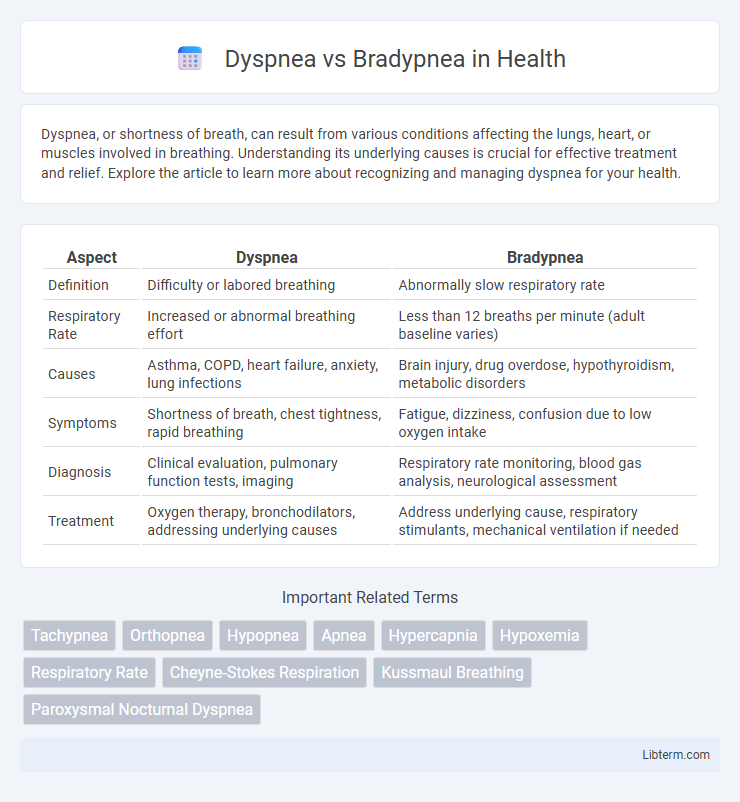Dyspnea, or shortness of breath, can result from various conditions affecting the lungs, heart, or muscles involved in breathing. Understanding its underlying causes is crucial for effective treatment and relief. Explore the article to learn more about recognizing and managing dyspnea for your health.
Table of Comparison
| Aspect | Dyspnea | Bradypnea |
|---|---|---|
| Definition | Difficulty or labored breathing | Abnormally slow respiratory rate |
| Respiratory Rate | Increased or abnormal breathing effort | Less than 12 breaths per minute (adult baseline varies) |
| Causes | Asthma, COPD, heart failure, anxiety, lung infections | Brain injury, drug overdose, hypothyroidism, metabolic disorders |
| Symptoms | Shortness of breath, chest tightness, rapid breathing | Fatigue, dizziness, confusion due to low oxygen intake |
| Diagnosis | Clinical evaluation, pulmonary function tests, imaging | Respiratory rate monitoring, blood gas analysis, neurological assessment |
| Treatment | Oxygen therapy, bronchodilators, addressing underlying causes | Address underlying cause, respiratory stimulants, mechanical ventilation if needed |
Understanding Dyspnea: Definition and Causes
Dyspnea is the clinical term for shortness of breath, characterized by an uncomfortable awareness of breathing difficulty caused by various respiratory or cardiovascular conditions. Common causes include asthma, chronic obstructive pulmonary disease (COPD), heart failure, and pulmonary embolism, which disrupt oxygen exchange and increase the effort required for breathing. In contrast, bradypnea refers to an abnormally slow respiratory rate, often linked to neurological impairments or drug effects, highlighting the distinction in symptoms and underlying mechanisms between these respiratory issues.
Exploring Bradypnea: Definition and Etiology
Bradypnea is characterized by an abnormally slow respiratory rate, typically fewer than 12 breaths per minute in adults, which can reduce oxygen intake and lead to hypoxia. Etiologies of bradypnea include central nervous system depression due to drug overdose, hypothyroidism, metabolic alkalosis, or severe brain injury affecting the respiratory centers. Unlike dyspnea, which involves the sensation of breathlessness, bradypnea primarily refers to diminished respiratory rate without necessarily causing subjective respiratory distress.
Key Differences Between Dyspnea and Bradypnea
Dyspnea refers to the subjective experience of difficult or uncomfortable breathing, often described as shortness of breath, whereas bradypnea is an objectively measured condition characterized by abnormally slow respiratory rates below 12 breaths per minute in adults. Dyspnea is primarily a symptom associated with various cardiac, pulmonary, or systemic conditions, while bradypnea signifies a physiological or pathological alteration in respiratory rhythm, commonly linked to central nervous system depression or metabolic disturbances. Key differences include dyspnea's nature as a sensation affecting quality of life and oxygenation, contrasted with bradypnea's definition as a quantifiable decrease in respiratory frequency impacting ventilation efficiency.
Common Symptoms Associated with Dyspnea
Dyspnea is characterized by labored or difficult breathing, often accompanied by symptoms such as chest tightness, rapid heartbeat, and fatigue. In contrast, bradypnea refers to an abnormally slow respiratory rate, typically below 12 breaths per minute, without the sensation of breathlessness. Common symptoms associated with dyspnea include shortness of breath, wheezing, and cyanosis, which are absent in bradypnea.
Recognizable Symptoms of Bradypnea
Bradypnea is characterized by abnormally slow breathing rates, typically fewer than 12 breaths per minute in adults, which can lead to symptoms such as fatigue, dizziness, and confusion due to insufficient oxygen levels. Unlike dyspnea, which involves labored or difficult breathing, bradypnea presents with a reduced respiratory rate and may result in hypoventilation and increased carbon dioxide retention. Recognizable symptoms of bradypnea include lethargy, bluish skin (cyanosis), and shortness of breath caused by inadequate ventilation.
Underlying Medical Conditions Linked to Dyspnea
Dyspnea, characterized by difficulty breathing, is commonly associated with underlying medical conditions such as chronic obstructive pulmonary disease (COPD), heart failure, asthma, pneumonia, and pulmonary embolism. Bradypnea, defined as an abnormally slow respiratory rate, may arise from central nervous system depression, hypothyroidism, drug overdose, or severe metabolic disorders, but does not inherently indicate dyspnea. Understanding the distinct pathophysiology and clinical presentations of dyspnea and bradypnea aids in accurate diagnosis and targeted treatment of respiratory and systemic illnesses.
Factors Contributing to Bradypnea
Bradypnea is characterized by an abnormally slow respiratory rate, often below 12 breaths per minute in adults, primarily caused by factors such as opioid overdose, hypothyroidism, brainstem injury, and certain types of electrolyte imbalances. This contrasts with dyspnea, which involves the subjective sensation of breathlessness and can occur with normal or altered respiratory rates. Understanding the pathophysiological mechanisms behind bradypnea is critical for accurate diagnosis and effective management in clinical settings.
Diagnostic Approaches for Dyspnea vs Bradypnea
Dyspnea diagnosis involves clinical evaluation, pulse oximetry, chest X-rays, and pulmonary function tests to identify underlying causes like asthma, heart failure, or lung disease. Bradypnea assessment requires monitoring respiratory rate, arterial blood gas analysis to detect hypoventilation or hypercapnia, and neurological examination to determine central nervous system abnormalities. Both conditions utilize telemetry and capnography to provide real-time respiratory status and guide treatment strategies.
Treatment Strategies for Dyspnea and Bradypnea
Treatment strategies for dyspnea focus on addressing the underlying cause, such as administering bronchodilators for asthma or corticosteroids for chronic obstructive pulmonary disease (COPD), alongside supplemental oxygen therapy to improve oxygenation. Management of bradypnea requires identifying the root cause, often involving intervention for opioid overdose with naloxone or adjusting medications causing respiratory depression, and in severe cases, mechanical ventilation support may be necessary. Both conditions necessitate continuous monitoring of respiratory rate, oxygen saturation, and arterial blood gases to guide therapeutic decisions and optimize patient outcomes.
When to Seek Medical Attention for Respiratory Distress
Seek immediate medical attention if dyspnea causes sudden difficulty breathing, chest pain, or blue lips, indicating potential respiratory failure or cardiac issues. Bradypnea with rates below 12 breaths per minute accompanied by confusion, fainting, or severe fatigue requires urgent evaluation for underlying conditions like drug overdose or brain injury. Persistent or worsening symptoms in either condition necessitate prompt healthcare intervention to prevent complications.
Dyspnea Infographic

 libterm.com
libterm.com